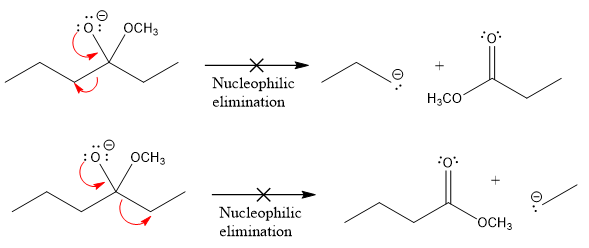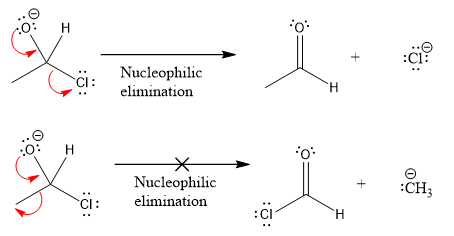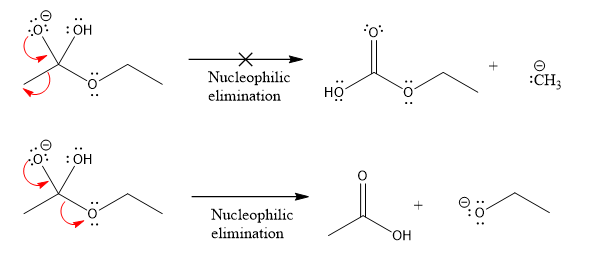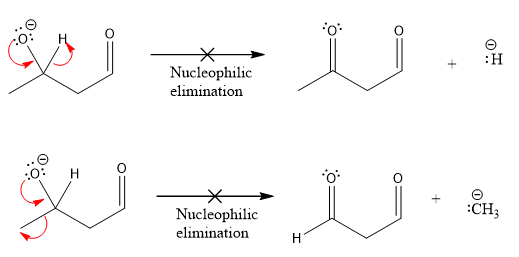
Concept explainers
(a)
Interpretation:
Whether the product of the given step can eliminate a leaving group to form a different compound than the reactant is to be predicted. The product for the given nucleophilic elimination step with appropriate curved arrows is to be drawn.
Concept introduction:
In the nucleophilic elimination step, the more electronegative atom bears full or partial negative charge. This is an electron rich atom, and the less electronegative atom is relatively electron poor. The curved arrow drawn from the lone pair of electron rich atom points to the bonding region between the more electronegative atom and less electronegative atom representing the electron flow from the electron rich site to the electron poor site. The second curved arrow is drawn to represent the breaking of the bond between the less electronegative atom and leaving group to avoid exceeding an octet on the less electronegative atom.
Answer to Problem 7.27P
Products formed after the elimination of the leaving group are not the same as the reactant. Product formed in the nucleophilic elimination step with appropriate curved arrows is drawn as:

Explanation of Solution
Product for the given nucleophilic addition step is:

In the given product, there are two possible groups that can leave to form two different products.
In the first nucleophilic elimination step, the oxygen atom with negative charge is an electron rich site, and the carbon bonded to it is an electron poor site. The curved arrow mechanism for this given nucleophilic elimination step forming the respective product is:

The first curved arrow is drawn from the lone pair of negatively charged oxygen to the mid of
The respective product formed is different from the reactant in the given nucleophilic addition step. The X sign on the arrow represents that this nucleophilic elimination is unfeasible as
In the second nucleophilic elimination step, the oxygen atom with negative charge is the electron rich site, and the carbon bonded to it is the electron poor site. The curved arrow mechanism for this given nucleophilic elimination step forming the respective product is:

The first curve arrow is drawn from the lone pair of negatively charged oxygen to the mid of
The respective product formed is different from the reactant in the given nucleophilic addition step. The X sign on the arrow represents that this nucleophilic elimination is unfeasible as
Products formed in the elimination steps are different from the reactant in the given nucleophilic addition step.
(b)
Interpretation:
Whether the product of the given step can eliminate a leaving group to form a different compound than the reactant is to be predicted. The product for the given nucleophilic elimination step with appropriate curved arrows is to be drawn.
Concept introduction:
In the nucleophilic elimination step, the more electronegative atom bears full negative charge or partial negative charge. This is the electron rich atom and the less electronegative atom is relatively electron poor. The curved arrow drawn from the lone pair of electron rich atom points to the bonding region between the more electronegative atom and less electronegative atom representing the electron flow from the electron rich site to the electron poor site. The second curved arrow is drawn to represent the breaking of bond between the less electronegative atom and leaving group to avoid exceeding an octet on the less electronegative atom.
Answer to Problem 7.27P
The product formed after the elimination of the leaving group is not the same as the reactant. Product formed in the nucleophilic elimination step with an appropriate curved arrow is drawn as:

Explanation of Solution
Product for the given nucleophilic addition step is:

In the nucleophilic elimination step, the oxygen atom with negative charge is an electron rich site, and the carbon bonded to it is an electron poor site. The curved arrow mechanism for this given nucleophilic elimination step forming the respective product is:

The first curved arrow is drawn from the lone pair of negatively charged oxygen to the mid of
The respective product formed is different from the reactant in the given nucleophilic addition step. The X sign on the arrow represents this nucleophilic elimination is unfeasible as
Product formed in the elimination step is different from the reactant in the given nucleophilic addition step.
(c)
Interpretation:
The product of the given step can eliminate a leaving group to form different compound than reactant is to be predicted. The product for the given nucleophilic elimination step with appropriate curved arrows is to be drawn.
Concept introduction:
In nucleophilic elimination step, the more electronegative atom bears full negative charge or partial negative charge. This is the electron rich atom and the less electronegative atom is relatively electron poor. The curved arrow drawn from the lone pair of electron rich atom points to the bonding region between the more electronegative atom and less electronegative atom representing the electron flow from electron rich site to electron poor site. The second curved arrow drawn to represent the breaking of bond between the less electronegative atom and leaving group to avoid exceeding an octet on the less electronegative atom.
Answer to Problem 7.27P
The products formed after the elimination of the leaving group are not the same as the reactant. Product formed in the nucleophilic elimination step with appropriate curved arrow is drawn as:

Explanation of Solution
Product for the given nucleophilic addition step is:

In the nucleophilic elimination step, the nitrogen atom with negative charge is electron rich site, and the carbon bonded to it is electron poor site. The curved arrow mechanism for this given nucleophilic elimination step forming the respective product is:

The first curved arrow is drawn from the lone pair of negatively charged nitrogen to the mid of
The respective product formed is different from the reactant in the given nucleophilic addition step. The X sign on the arrow represents this nucleophilic elimination is unfeasible as
Product formed in the elimination step is different from the reactant in the given nucleophilic addition step.
(d)
Interpretation:
Whether the product of the given step can eliminate a leaving group to form different compound than reactant is to be predicted. The product for the given nucleophilic elimination step with appropriate curved arrows is to be drawn.
Concept introduction:
In nucleophilic elimination step, the more electronegative atom bears full negative charge or partial negative charge. This is the electron rich atom and the less electronegative atom is relatively electron poor. The curved arrow drawn from the lone pair of electron rich atom points to the bonding region between the more electronegative atom and less electronegative atom representing the electron flow from electron rich site to electron poor site. The second curved arrow is drawn to represent the breaking of bond between the less electronegative atom and leaving group to avoid exceeding an octet on the less electronegative atom.
Answer to Problem 7.27P
Products formed after the elimination of the leaving group are not the same as the reactant. Product formed in the nucleophilic elimination step with appropriate curved arrow is drawn as:

Explanation of Solution
Product for the given nucleophilic addition step is:

In the first nucleophilic elimination step, the oxygen atom with negative charge is electron rich site, and the chlorine atom is a good leaving group. The curved arrow mechanism for this given nucleophilic elimination step forming the respective product is:

The first curved arrow is drawn from the lone pair of negatively charged oxygen to the mid of
The respective product formed is different from the reactant in the given nucleophilic addition step.
In the second nucleophilic elimination step, the oxygen atom with negative charge is electron rich site and the carbon bonded to it is electron poor site. The curved arrow mechanism for this given nucleophilic elimination step forming the respective product is:

The first curved arrow is drawn from the lone pair of negatively charged oxygen to the mid of
The respective product formed is different from the reactant in the given nucleophilic addition step. The X sign on the arrow represents this nucleophilic elimination is unfeasible as
Products formed in the elimination steps are different from the reactant in the given nucleophilic addition step.
(e)
Interpretation:
Whether the product of the given step can eliminate a leaving group to form different compound than reactant is to be predicted. The product for the given nucleophilic elimination step with appropriate curved arrows is to be drawn.
Concept introduction:
In nucleophilic elimination step, the more electronegative atom bears full negative charge or partial negative charge. This is the electron rich atom and the less electronegative atom is relatively electron poor. The curved arrow is drawn from the lone pair of electron rich atom points to the bonding region between the more electronegative atom and less electronegative atom representing the electron flow from electron rich site to electron poor site. The second curved arrow is drawn to represent the breaking of bond between the less electronegative atom and leaving group to avoid exceeding an octet on the less electronegative atom.
Answer to Problem 7.27P
Products formed after the elimination of the leaving group are not same as the reactant. Product formed in the nucleophilic elimination step with appropriate curved arrow is drawn as:

Explanation of Solution
Product for the given nucleophilic addition step is:

In the given product, there are two possible groups that can leave to form two different products.
In the first nucleophilic elimination step, the oxygen atom with negative charge is electron rich site, and the carbon bonded to it is electron poor site. The curved arrow mechanism for this given nucleophilic elimination step forming the respective product is:

The first curved arrow is drawn from the lone pair of negatively charged oxygen to the mid of
The respective product formed is different from the reactant in the given nucleophilic addition step. The X sign on the arrow represents this nucleophilic elimination is unfeasible as
In the second nucleophilic elimination step, the oxygen atom with negative charge is electron rich site and

The first curved arrow is drawn from the lone pair of negatively charged oxygen to the mid of
The respective product formed is different from the reactant in the given nucleophilic addition step.
Products formed in the elimination steps are different from the reactant in the given nucleophilic addition step.
(f)
Interpretation:
Whether the product of the given step can eliminate a leaving group to form different compound than reactant is to be predicted. The product for the given nucleophilic elimination step with appropriate curved arrows is to be drawn.
Concept introduction:
In nucleophilic elimination step, the more electronegative atom bears full negative charge or partial negative charge. This is the electron rich atom and the less electronegative atom is relatively electron poor. The curved arrow drawn from the lone pair of electron rich atom points to bonding region between the more electronegative atom and less electronegative atom representing the electron flow from electron rich site to electron poor site. The second curved arrow is drawn to represent the breaking of bond between the less electronegative atom and leaving group to avoid exceeding an octet on the less electronegative atom.
Answer to Problem 7.27P
Products formed after the elimination of the leaving group are not same as the reactant. Product formed in the nucleophilic elimination step with appropriate curved arrow is drawn as:

Explanation of Solution
Product for the given nucleophilic addition step is:

In the given product, there are two possible groups that can leave to form two different products.
In the first nucleophilic elimination step, the oxygen atom with negative charge is electron rich site and the carbon bonded to it is electron poor site. The curved arrow mechanism for this given nucleophilic elimination step forming the respective product is:

The first curved arrow is drawn from the lone pair of negatively charged oxygen to the mid of
The respective product formed is different from the reactant in the given nucleophilic addition step. The X sign on the arrow represents this nucleophilic elimination is unfeasible as
The second nucleophilic elimination step, the oxygen atom with negative charge is electron rich site and the carbon bonded to it is electron poor site. The curved arrow mechanism for this given nucleophilic elimination step forming the respective product is:

The first curved arrow is drawn from the lone pair of negatively charged oxygen to the mid of
The respective product formed is different from the reactant in the given nucleophilic addition step. The X sign on the arrow represents this nucleophilic elimination is unfeasible as
Products formed in the elimination steps are different from the reactant in the given nucleophilic addition step.
Want to see more full solutions like this?
Chapter 7 Solutions
Organic Chemistry: Principles And Mechanisms (second Edition)
- dict the major products of this organic reaction. C Explanation Check 90 + 1.0₂ 3 2. (CH3)2S Click and drag f drawing a stru © 2025 McGraw Hill LLC. All Rights Reserved. • 22 4 5 7 8 Y W E R S F H Bilarrow_forwardcan someone draw out the reaction mechanism for this reaction showing all the curly arrows and 2. Draw the GPNA molecule and identify the phenylalanine portion. 3. Draw L-phenylalanine with the correct stereochemistryarrow_forwardWhat is the reaction mechanism for this?arrow_forward
- Predict the major products of both organic reactions. Be sure to use wedge and dash bonds to show the stereochemistry of the products when it's important, for example to distinguish between two different major products. esc esc Explanation Check 2 : + + X H₁₂O + Х ง WW E R Y qab Ccaps lock shift $ P X Click and drag to start drawing a structure. © 2025 McGraw Hill LLC. All Rights Reserved. Terms of Use | Privacy Center | Accessibility Bil T FR F18 9 G t K L Z X V B N M control opption command command T C darrow_forwardDraw the Markovnikov product of the hydrohalogenation of this alkene. this problem. Note for advanced students: draw only one product, and don't worry about showing any stereochemistry. Drawing dash and wedge bonds has been disabled for caps lock Explanation Check 2 W E R + X 5 HCI Click and drag to start drawing a structure. © 2025 McGraw Hill LLC. All Rights Reserved. Terms of Use | Privacy Center | Accessibility Bil Y F G H K L ZZ X C V B N M control opption command F10 F10 command 4 BA Ar Carrow_forwardI don't understand why the amide on the top left, with the R attached to one side, doesn't get substituted with OH to form a carboxylic acid. And if only one can be substituted, why did it choose the amide it chose rather than the other amide?arrow_forward
- esc Draw the Markovnikov product of the hydration of this alkene. Note for advanced students: draw only one product, and don't worry about showing any stereochemistry. Drawing dash and wedge bonds has been disabled for this problem. Explanation Check BBB + X 0 1. Hg (OAc)2, H₂O 2. Na BH 5 Click and drag to start drawing a structure. © 2025 McGraw Hill LLC. All Rights Reserved. Terms of Use | Privacy Center | Accessibility Bl P 豆 28 2 28 N 9 W E R T Y A S aps lock G H K L Z X C V B N M T central H command #e commandarrow_forwardC A student proposes the transformation below in one step of an organic synthesis. There may be one or more products missing from the right-hand side, but there are no reagents missing from the left-hand side. There may also be catalysts, small inorganic reagents, and other important reaction conditions missing from the arrow. • Is the student's transformation possible? If not, check the box under the drawing area. . If the student's transformation is possible, then complete the reaction by adding any missing products to the right-hand side, and adding required catalysts, inorganic reagents, or other important reaction conditions above and below the arrow. • You do not need to balance the reaction, but be sure every important organic reactant or product is shown. (X) This transformation can't be done in one step. + Tarrow_forwardく Predict the major products of this organic reaction. If there aren't any products, because nothing will happen, check the box under the drawing area instead. No reaction. Explanation Check OH + + ✓ 2 H₂SO 4 O xs H₂O 2 Click and drag to start drawing a structure. © 2025 McGraw Hill LLC. All Rights Reserved. Terms of Use | Privacy Centerarrow_forward
- Draw the skeletal ("line") structure of 1,3-dihydroxy-2-pentanone. Click and drag to start drawing a structure. X Parrow_forwardPredicting edict the major products of this organic reaction. If there aren't any products, because nothing will happen, check the box under the drawing area instead. + No reaction. Explanation Check HO Na O H xs H₂O 2 Click and drag to start drawing a structure. © 2025 McGraw Hill LLC. All Rights Reserved. Terms of Use | Privacy Center Iarrow_forwardChoosing reagents and conditions for acetal formation or hydrolysis 0/5 A student proposes the transformation below in one step of an organic synthesis. There may be one or more products missing from the right-hand side, but there are no reagents missing from the left-hand side. There may also be catalysts, small inorganic reagents, and other important reaction conditions missing from the arrow. • Is the student's transformation possible? If not, check the box under the drawing area. If the student's transformation is possible, then complete the reaction by adding any missing products to the right-hand side, and adding required catalysts, inorganic reagents, or other important reaction conditions above and below the arrow. • You do not need to balance the reaction, but be sure every important organic reactant or product is shown. + This transformation can't be done in one step. 5 I H Autumn alo 值 Ar Barrow_forward
 Organic Chemistry: A Guided InquiryChemistryISBN:9780618974122Author:Andrei StraumanisPublisher:Cengage Learning
Organic Chemistry: A Guided InquiryChemistryISBN:9780618974122Author:Andrei StraumanisPublisher:Cengage Learning
